Guanding Yu
Sensing Framework Design and Performance Optimization with Action Detection for ISCC
May 05, 2025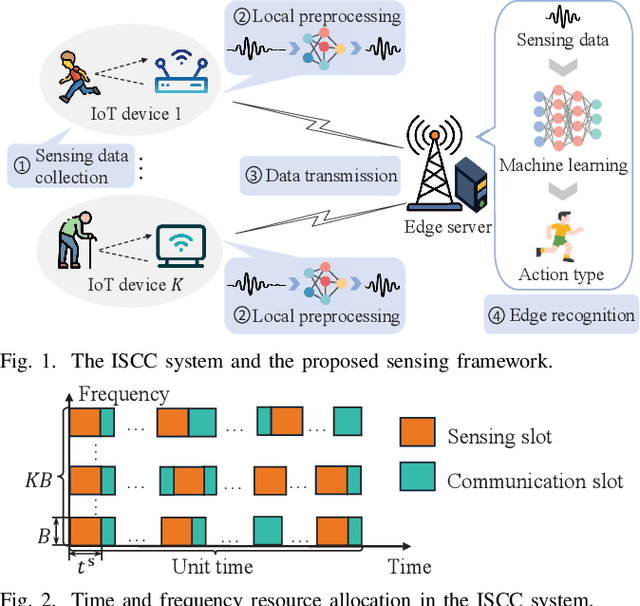
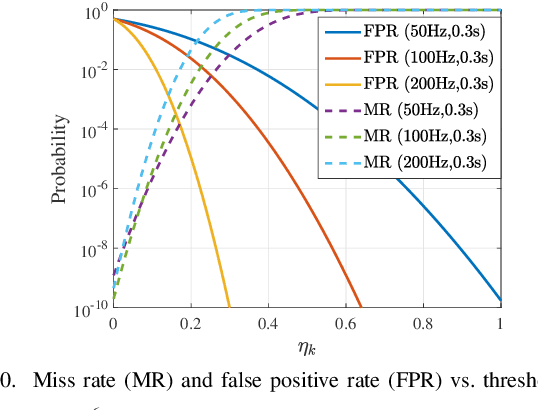
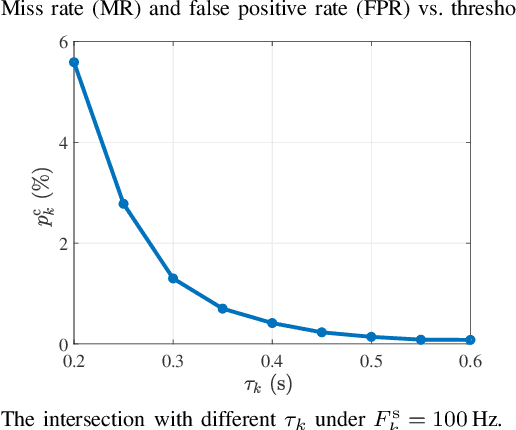
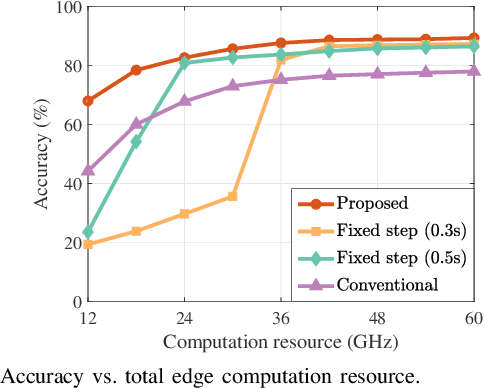
Abstract:Integrated sensing, communication, and computation (ISCC) has been regarded as a prospective technology for the next-generation wireless network, supporting humancentric intelligent applications. However, the delay sensitivity of these computation-intensive applications, especially in a multidevice ISCC system with limited resources, highlights the urgent need for efficient sensing task execution frameworks. To address this, we propose a resource-efficient sensing framework in this paper. Different from existing solutions, it features a novel action detection module deployed at each device to detect the onset of an action. Only time windows filled with signals of interest are offloaded to the edge server and processed by the edge recognition module, thus reducing overhead. Furthermore, we quantitatively analyze the sensing performance of the proposed sensing framework and formulate a sensing accuracy maximization problem under power, delay, and resource limitations for the multi-device ISCC system. By decomposing it into two subproblems, we develop an alternating direction method of multipliers (ADMM)-based distributed algorithm. It alternatively solves a sensing accuracy maximization subproblem at each device and employs a closed-form computation resource allocation strategy at the edge server till convergence. Finally, a real-world test is conducted using commodity wireless devices to validate the sensing performance analysis. Extensive test results demonstrate that our proposal achieves higher sensing accuracy under the limited resource compared to two baselines.
Online Conformal Probabilistic Numerics via Adaptive Edge-Cloud Offloading
Mar 18, 2025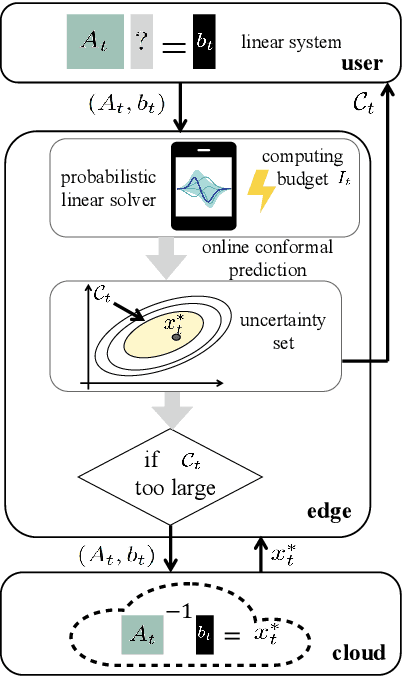
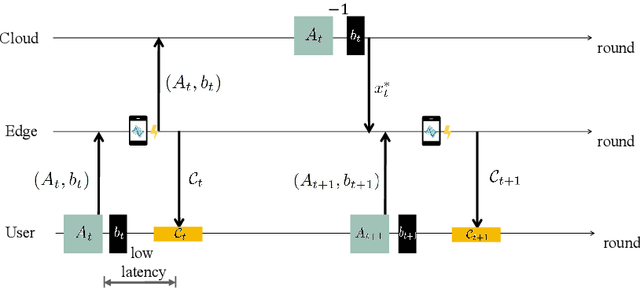


Abstract:Consider an edge computing setting in which a user submits queries for the solution of a linear system to an edge processor, which is subject to time-varying computing availability. The edge processor applies a probabilistic linear solver (PLS) so as to be able to respond to the user's query within the allotted time and computing budget. Feedback to the user is in the form of an uncertainty set. Due to model misspecification, the uncertainty set obtained via a direct application of PLS does not come with coverage guarantees with respect to the true solution of the linear system. This work introduces a new method to calibrate the uncertainty sets produced by PLS with the aim of guaranteeing long-term coverage requirements. The proposed method, referred to as online conformal prediction-PLS (OCP-PLS), assumes sporadic feedback from cloud to edge. This enables the online calibration of uncertainty thresholds via online conformal prediction (OCP), an online optimization method previously studied in the context of prediction models. The validity of OCP-PLS is verified via experiments that bring insights into trade-offs between coverage, prediction set size, and cloud usage.
Graph Neural Network for Location- and Orientation-Assisted mmWave Beam Alignment
Mar 10, 2025Abstract:In massive multi-input multi-output (MIMO) systems, the main bottlenecks of location- and orientation-assisted beam alignment using deep neural networks (DNNs) are large training overhead and significant performance degradation. This paper proposes a graph neural network (GNN)-based beam selection approach that reduces the training overhead and improves the alignment accuracy, by capitalizing on the strong expressive ability and few trainable parameters of GNN. The channels of beams are correlated according to the beam direction. Therefore, we establish a graph according to the angular correlation between beams and use GNN to capture the channel correlation between adjacent beams, which helps accelerate the learning process and enhance the beam alignment performance. Compared to existing DNN-based algorithms, the proposed method requires only 20\% of the dataset size to achieve equivalent accuracy and improves the Top-1 accuracy by 10\% when using the same dataset.
Joint Transmission and Deblurring: A Semantic Communication Approach Using Events
Jan 16, 2025



Abstract:Deep learning-based joint source-channel coding (JSCC) is emerging as a promising technology for effective image transmission. However, most existing approaches focus on transmitting clear images, overlooking real-world challenges such as motion blur caused by camera shaking or fast-moving objects. Motion blur often degrades image quality, making transmission and reconstruction more challenging. Event cameras, which asynchronously record pixel intensity changes with extremely low latency, have shown great potential for motion deblurring tasks. However, the efficient transmission of the abundant data generated by event cameras remains a significant challenge. In this work, we propose a novel JSCC framework for the joint transmission of blurry images and events, aimed at achieving high-quality reconstructions under limited channel bandwidth. This approach is designed as a deblurring task-oriented JSCC system. Since RGB cameras and event cameras capture the same scene through different modalities, their outputs contain both shared and domain-specific information. To avoid repeatedly transmitting the shared information, we extract and transmit their shared information and domain-specific information, respectively. At the receiver, the received signals are processed by a deblurring decoder to generate clear images. Additionally, we introduce a multi-stage training strategy to train the proposed model. Simulation results demonstrate that our method significantly outperforms existing JSCC-based image transmission schemes, addressing motion blur effectively.
ROME: Robust Model Ensembling for Semantic Communication Against Semantic Jamming Attacks
Jan 02, 2025Abstract:Recently, semantic communication (SC) has garnered increasing attention for its efficiency, yet it remains vulnerable to semantic jamming attacks. These attacks entail introducing crafted perturbation signals to legitimate signals over the wireless channel, thereby misleading the receivers' semantic interpretation. This paper investigates the above issue from a practical perspective. Contrasting with previous studies focusing on power-fixed attacks, we extensively consider a more challenging scenario of power-variable attacks by devising an innovative attack model named Adjustable Perturbation Generator (APG), which is capable of generating semantic jamming signals of various power levels. To combat semantic jamming attacks, we propose a novel framework called Robust Model Ensembling (ROME) for secure semantic communication. Specifically, ROME can detect the presence of semantic jamming attacks and their power levels. When high-power jamming attacks are detected, ROME adapts to raise its robustness at the cost of generalization ability, and thus effectively accommodating the attacks. Furthermore, we theoretically analyze the robustness of the system, demonstrating its superiority in combating semantic jamming attacks via adaptive robustness. Simulation results show that the proposed ROME approach exhibits significant adaptability and delivers graceful robustness and generalization ability under power-variable semantic jamming attacks.
Towards Compatible Semantic Communication: A Perspective on Digital Coding and Modulation
Dec 25, 2024



Abstract:Semantic communication (SC) is emerging as a pivotal innovation within the 6G framework, aimed at enabling more intelligent transmission. This development has led to numerous studies focused on designing advanced systems through powerful deep learning techniques. Nevertheless, many of these approaches envision an analog transmission manner by formulating the transmitted signals as continuous-valued semantic representation vectors, limiting their compatibility with existing digital systems. To enhance compatibility, it is essential to explore digitized SC systems. This article systematically identifies two promising paradigms for designing digital SC: probabilistic and deterministic approaches, according to the modulation strategies. For both, we first provide a comprehensive analysis of the methodologies. Then, we put forward the principles of designing digital SC systems with a specific focus on informativeness and robustness of semantic representations to enhance performance, along with constellation design. Additionally, we present a case study to demonstrate the effectiveness of these methods. Moreover, this article also explores the intrinsic advantages and opportunities provided by digital SC systems, and then outlines several potential research directions for future investigation.
Coarse-to-Fine: A Dual-Phase Channel-Adaptive Method for Wireless Image Transmission
Dec 11, 2024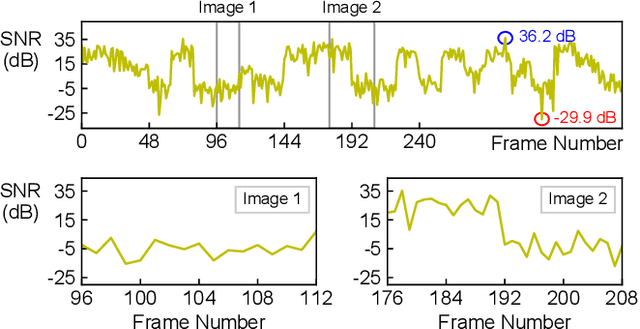
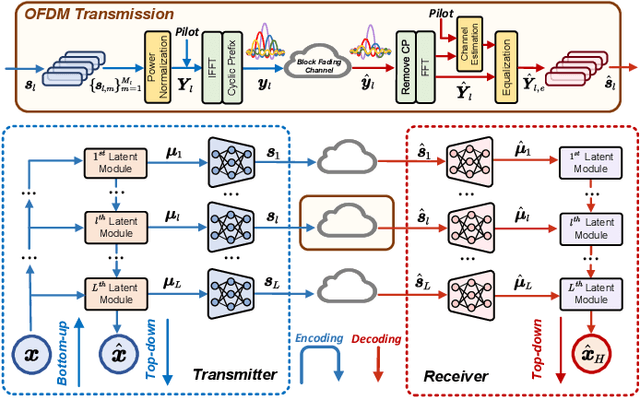
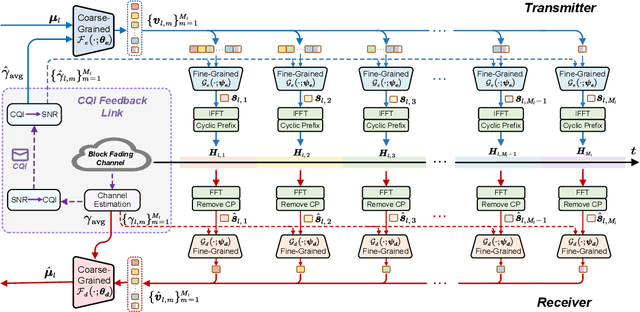
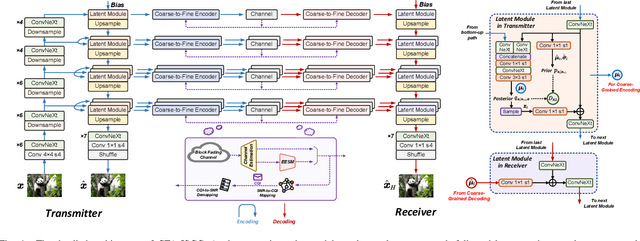
Abstract:Developing channel-adaptive deep joint source-channel coding (JSCC) systems is a critical challenge in wireless image transmission. While recent advancements have been made, most existing approaches are designed for static channel environments, limiting their ability to capture the dynamics of channel environments. As a result, their performance may degrade significantly in practical systems. In this paper, we consider time-varying block fading channels, where the transmission of a single image can experience multiple fading events. We propose a novel coarse-to-fine channel-adaptive JSCC framework (CFA-JSCC) that is designed to handle both significant fluctuations and rapid changes in wireless channels. Specifically, in the coarse-grained phase, CFA-JSCC utilizes the average signal-to-noise ratio (SNR) to adjust the encoding strategy, providing a preliminary adaptation to the prevailing channel conditions. Subsequently, in the fine-grained phase, CFA-JSCC leverages instantaneous SNR to dynamically refine the encoding strategy. This refinement is achieved by re-encoding the remaining channel symbols whenever the channel conditions change. Additionally, to reduce the overhead for SNR feedback, we utilize a limited set of channel quality indicators (CQIs) to represent the channel SNR and further propose a reinforcement learning (RL)-based CQI selection strategy to learn this mapping. This strategy incorporates a novel reward shaping scheme that provides intermediate rewards to facilitate the training process. Experimental results demonstrate that our CFA-JSCC provides enhanced flexibility in capturing channel variations and improved robustness in time-varying channel environments.
Learned Image Transmission with Hierarchical Variational Autoencoder
Sep 04, 2024



Abstract:In this paper, we introduce an innovative hierarchical joint source-channel coding (HJSCC) framework for image transmission, utilizing a hierarchical variational autoencoder (VAE). Our approach leverages a combination of bottom-up and top-down paths at the transmitter to autoregressively generate multiple hierarchical representations of the original image. These representations are then directly mapped to channel symbols for transmission by the JSCC encoder. We extend this framework to scenarios with a feedback link, modeling transmission over a noisy channel as a probabilistic sampling process and deriving a novel generative formulation for JSCC with feedback. Compared with existing approaches, our proposed HJSCC provides enhanced adaptability by dynamically adjusting transmission bandwidth, encoding these representations into varying amounts of channel symbols. Additionally, we introduce a rate attention module to guide the JSCC encoder in optimizing its encoding strategy based on prior information. Extensive experiments on images of varying resolutions demonstrate that our proposed model outperforms existing baselines in rate-distortion performance and maintains robustness against channel noise.
Automatic AI Model Selection for Wireless Systems: Online Learning via Digital Twinning
Jun 22, 2024



Abstract:In modern wireless network architectures, such as O-RAN, artificial intelligence (AI)-based applications are deployed at intelligent controllers to carry out functionalities like scheduling or power control. The AI "apps" are selected on the basis of contextual information such as network conditions, topology, traffic statistics, and design goals. The mapping between context and AI model parameters is ideally done in a zero-shot fashion via an automatic model selection (AMS) mapping that leverages only contextual information without requiring any current data. This paper introduces a general methodology for the online optimization of AMS mappings. Optimizing an AMS mapping is challenging, as it requires exposure to data collected from many different contexts. Therefore, if carried out online, this initial optimization phase would be extremely time consuming. A possible solution is to leverage a digital twin of the physical system to generate synthetic data from multiple simulated contexts. However, given that the simulator at the digital twin is imperfect, a direct use of simulated data for the optimization of the AMS mapping would yield poor performance when tested in the real system. This paper proposes a novel method for the online optimization of AMS mapping that corrects for the bias of the simulator by means of limited real data collected from the physical system. Experimental results for a graph neural network-based power control app demonstrate the significant advantages of the proposed approach.
From Analog to Digital: Multi-Order Digital Joint Coding-Modulation for Semantic Communication
Jun 08, 2024
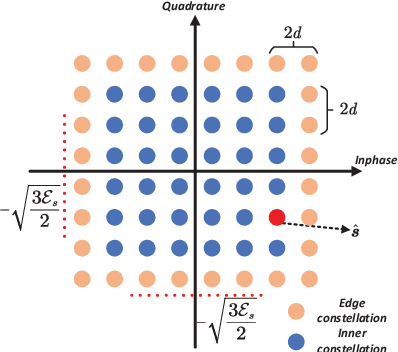
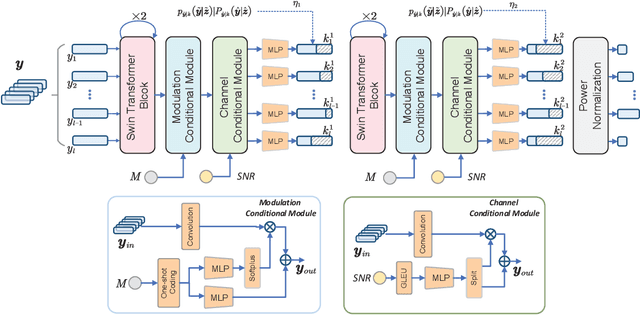
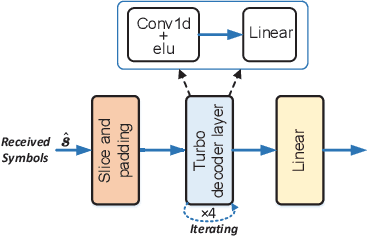
Abstract:Recent studies in joint source-channel coding (JSCC) have fostered a fresh paradigm in end-to-end semantic communication. Despite notable performance achievements, present initiatives in building semantic communication systems primarily hinge on the transmission of continuous channel symbols, thus presenting challenges in compatibility with established digital systems. In this paper, we introduce a novel approach to address this challenge by developing a multi-order digital joint coding-modulation (MDJCM) scheme for semantic communications. Initially, we construct a digital semantic communication system by integrating a multi-order modulation/demodulation module into a nonlinear transform source-channel coding (NTSCC) framework. Recognizing the non-differentiable nature of modulation/demodulation, we propose a novel substitution training strategy. Herein, we treat modulation/demodulation as a constrained quantization process and introduce scaling operations alongside manually crafted noise to approximate this process. As a result, employing this approximation in training semantic communication systems can be deployed in practical modulation/demodulation scenarios with superior performance. Additionally, we demonstrate the equivalence by analyzing the involved probability distribution. Moreover, to further upgrade the performance, we develop a hierarchical dimension-reduction strategy to provide a gradual information extraction process. Extensive experimental evaluations demonstrate the superiority of our proposed method over existing digital and non-digital JSCC techniques.
 Add to Chrome
Add to Chrome Add to Firefox
Add to Firefox Add to Edge
Add to Edge